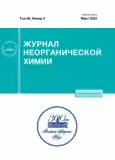The Effect of Silver Content in ZnO–Ag Nanoparticles on Their Photochemical and Antibacterial Activity
- Autores: Bakina O.V.1, Chzhou V.R.1, Ivanova L.Y.1, Kazantsev S.O.1
-
Afiliações:
- Institute of Strength Physics and Materials Science, Siberian Branch, Russian Academy of Sciences
- Edição: Volume 68, Nº 3 (2023)
- Páginas: 401-410
- Seção: НЕОРГАНИЧЕСКИЕ МАТЕРИАЛЫ И НАНОМАТЕРИАЛЫ
- URL: https://journals.rcsi.science/0044-457X/article/view/136345
- DOI: https://doi.org/10.31857/S0044457X22601249
- EDN: https://elibrary.ru/JBZGLV
- ID: 136345
Citar
Texto integral
Resumo
The development of new materials with antibacterial properties is a promising direction in the field of nanotechnology. In this work, ZnO–Ag nanoparticles with a silver content of 0.1–50 at % have been fabricated by the exploding wire method. ZnO–Ag nanoparticles absorb visible light and destroy the model dye Rhodamine B. The introduction of silver into nanoparticles has made it possible to shift the main absorption edge to 1.59–2.74 eV. The determined optimal content of silver in nanoparticles of 12 at % has ensured the degree of Rhodamine B decoloration by 85% within 60 min of exposure to visible light and has completely stopped the growth of E. coli bacteria at a concentration of 15.6 µg/mL. In addition, nanoparticles containing 12 at % silver have sterilized a sample of natural water contaminated with microorganisms. The results obtained offer an efficient method for the synthesis of antibacterial nanocomposites with heterojunctions employing a high-performance technique for producing nanoparticles, namely, the exploding wire method.
Palavras-chave
Sobre autores
O. Bakina
Institute of Strength Physics and Materials Science, Siberian Branch, Russian Academy of Sciences
Email: ovbakina@ispms.tsc.ru
634021, Tomsk, Russia
V. Chzhou
Institute of Strength Physics and Materials Science, Siberian Branch, Russian Academy of Sciences
Email: ovbakina@ispms.tsc.ru
634021, Tomsk, Russia
L. Ivanova
Institute of Strength Physics and Materials Science, Siberian Branch, Russian Academy of Sciences
Email: ovbakina@ispms.tsc.ru
634021, Tomsk, Russia
S. Kazantsev
Institute of Strength Physics and Materials Science, Siberian Branch, Russian Academy of Sciences
Autor responsável pela correspondência
Email: ovbakina@ispms.tsc.ru
634021, Tomsk, Russia
Bibliografia
- Kollef M.H., Torres A., Shorr A.F. et al. // Crit. Care Med. 2021. V. 49. № 2. P. 169. https://doi.org/10.1097/CCM.0000000000004783
- Gupta A., Mumtaz S., Li C.H. et al. // Chem. Soc. Rev. 2019. V. 48. P. 415. https://doi.org/10.1039/c7cs00748e
- Sharmin S., Rahaman M.M., Sarkar C. et al. // Heliyon. 2021. V. 7. № 3. P. e06456. https://doi.org/10.1016/j.heliyon.2021.e06456
- Correa M.G., Martínez F.B., Vidalet C.P. et al. // Beilstein J. Nanotechnol. 2020. V. 11. № 1. P. 1450. https://doi.org/10.3762/bjnano.11.129
- Jiang W.Y., Ran S.Y. // J. Chem. Phys. 2018. V. 148. № 20. P. 205102. https://doi.org/10.1063/1.5025348
- Akter M., Sikder M.T., Rahman M.M. et al. // J. Adv. Res. 2018. V. 9. P. 1. https://doi.org/10.1016/j.jare.2017.10.008
- Li H., Zhou X., Huang Y. et al. // Front. Microbiol. 2021. V. 11. P. 622534. https://doi.org/10.3389/fmicb.2020.62253
- Borysiewicz M.A. // Crystals. 2019. V. 9. № 10. P. 505. https://doi.org/10.3390/cryst9100505
- Alharthi F.A., Alghamdi A.A., Al-Zaqri N. et al. // Scie. Rep. 2020. V. 10. № 1. P. 1. https://doi.org/10.1038/s41598-020-77426-y
- Intaphonga P., Phurangrata A., Yeebua H. et al. // Russ. J. Inorg. Chem. 2021. V. 66. № 14. P. 2121. https://doi.org/10.1134/S0036023621140047
- Deng Q., Duan X., Ng D.H.L. et al. // ACS Appl. Mater. Interfaces. 2012. V. 4. P. 6030. https://doi.org/10.1021/am301682g
- Chomkitichai W., Jansanthea P., Channei D. // Russ. J. Inorg. Chem. 2021. V. 66. № 13. P. 1995. https://doi.org/10.1134/S0036023621130027
- Dymnikova N.S., Erokhina E.V., Moryganov A.P. // Russ. J. Gen. Chem. 2021. V. 91. № 3. P. 564. https://doi.org/10.1134/S1070363221030270
- Burlibaşa L., Chifiriuc M.C., Lungu M.V. et al. // Arabian J. Chem. 2020. V. 13. № 2. P. 4180. https://doi.org/10.1016/j.arabjc.2019.06.015
- Li Z. Zhang F., Meng A. et al. // RSC Adv. 2015. V. 5. № 1. P. 612. https://doi.org/10.1039/C4RA12319K
- Thatikayala D., Banothu V., Kim J. et al. // J. Mater. Sci. 2020. V. 31. № 7. P. 5324. https://doi.org/10.1007/s10854-020-03093-4
- El-Nahhal I.M., Lee K.M., Hwang S. et al. // Sci. Rep. 2020. V. 10. № 1. P. 1. https://doi.org/10.1038/s41598-020-61306-6
- Zare M., Namratha K., Alghamdi S. et al. // Sci. Rep. 2019. V. 9. № 1. P. 1. https://doi.org/10.1038/s41598-019-44309-w
- Tauc J., Grigorovici R., Vancu A. et al. // Phys. Status Solidi. 1966. V. 2. № 15. P. 627. https://doi.org/10.1002/pssb.19660150224
- Rani S., Aggarwal M., Kumar M. et al. // Water Sci. 2016. V. 30. № 1. P. 51. https://doi.org/10.1016/j.wsj.2016.04.001
- M07-A9 CLSI 2012 “Methods for Dilution Antimicrobial Susceptibility Tests for Bacteria That Grow Aerobically; Approved Standard – Ninth Edition”. https://clsi.org/standards/products/microbiology/documents/m07/
- Bakina O.V., Glazkova E.A., Pervikov A.V. et al. // J. Mater. Sci.-Mater. Electron. 2021. V. 32. № 8. P. 10623. https://doi.org/10.1007/s10854-019-01684-4
- Ferreira N.S., Sasaki J.M., Silva Jr R.S. et al. // Inorg. Chem. 2021. V. 60. № 7. P. 4475. https://doi.org/10.1021/acs.inorgchem.0c03327
- Chiu Y.H., Mark Chang T.F., Chen C.Y. et al. // Catalysts. 2019. V. 9. P. 430. https://doi.org/10.3390/catal9050430
- Yang J., Luo X. // Appl. Surf. Sci. 2021. V. 542. P. 148724. https://doi.org/10.1016/j.apsusc.2020.148724
- Panwar A., Yadav K.L. // Mater. Lett. 2022. V. 309. P. 131469. https://doi.org/10.1016/j.matlet.2021.131469
- Kumar T.K.M.P., Mandlimath T.R., Sangeetha P. et al. // RSC Adv. 2015. V. 5. № 130. P 108034. https://doi.org/10.1039/C5RA19945J
- Khoshkbejari M., Jafari A., Safari M. // Orient. J. Chem. 2015. V. 31. № 3. P. 1437. https://doi.org/10.13005/ojc/310322
- Adhikari S., Banerjee A., Eswar N.K.R. et al. // RSC Adv. 2015. V. 5. № 63. P. 51067. https://doi.org/10.1039/C5RA06406F
Arquivos suplementares
















